Wolgan Valley disaster raises questions about viability of living in certain parts of Australia
The closure of Wolgan Gap Rd has turned Wolgan Valley, less than 100km from the outskirts of Sydney, into one of the most isolated parts of Australia.
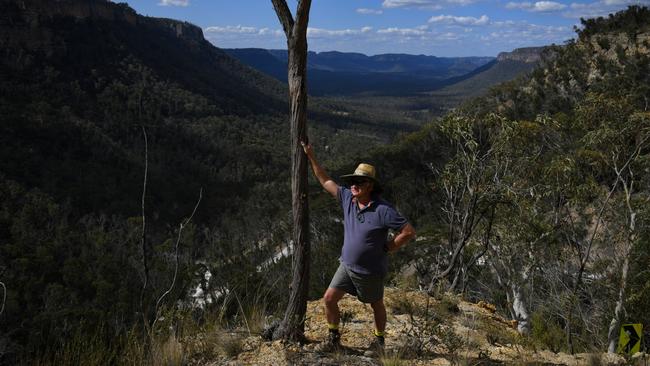
First came the fires, then came the rains and then the road gave way – the only road in and out. By crow, the Wolgan Valley is less than 100km from the outskirts of Sydney, yet it is now one of the most isolated places in Australia. In November last year, the Lithgow council closed the Wolgan Gap Rd because of landslides. It has been closed ever since.
Businesses have folded, livelihoods have been ruined, cattle are stranded, farms and houses are unsellable and Australia’s most expensive hotel, the $160m Emirates One&Only Wolgan Valley resort has closed its doors and 90 staff have been made redundant. It could be years before a new road is open to cars and trucks.
Late in 2019, the region was terrorised by the Gosper’s Mountain fire. More than a million hectares were engulfed in Australia’s biggest forest fire and dozens of houses were destroyed. Then came the rains, like never before. Across a rolling 12-month period, the area had 2½ times as much rain as they’d had since records began in the 1800s.
The mountain gave way. On November 9 last year, the Wolgan Gap Rd was closed. Massive tension cracks had developed – 40m in length, 2m deep and 600mm wide – which could give way at any time. If that happened, tens of thousands of tonnes of soil and rock would cascade down the mountain. It’s now closed forever because of the likelihood of “catastrophic collapse”.
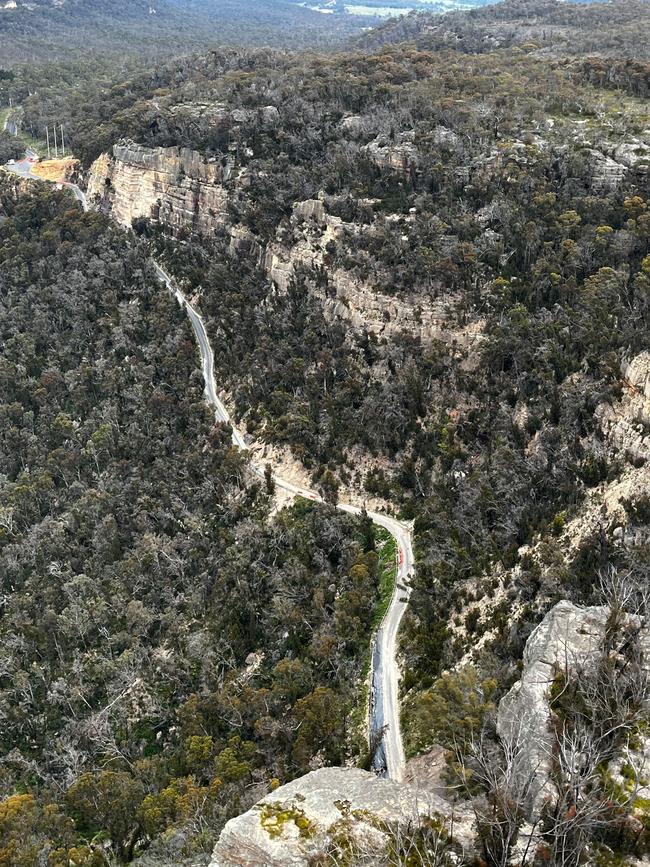
The Wolgan Valley Association has been told it may have to hand back a million-dollar federal grant (to be matched by $1m from the NSW government) to build a new community fire shelter. They are unlikely to be able to spend the money in the allotted period because, of course, the road is closed and they can’t get supplies and equipment in.
The disaster in the Wolgan Valley raises questions about the viability of living in certain parts of Australia. With the onset of more extreme weather, will some areas of the country simply become too expensive, or too dangerous, for human habitation?
Naturally rugged
To get to the grandeur of the Wolgan Valley, you take a right at the old Wallerawang Power Station, north of Lithgow, where two towering chimneys once loomed. Before they were felled a couple of years ago, these chimneys belched six million tonnes of carbon dioxide into the atmosphere every year for 60-odd years.
It was not far from here that a brilliant young Englishman first pencilled an idea that would lead to a revolution in human thought. In 1836, after sailing into Sydney Harbour on the HMS Beagle, 26-year-old Charles Darwin saddled up for an 11-day adventure into the Blue Mountains.
After a few days’ rugged riding, the young scientist bunked at the homestead at Wallerawang (pastoral) Station and on the morning of January 19, he was taken down into the magnificent Wolgan Valley by an affable Scot called Andrew Browne. Hemmed in by dramatic sandstone cliffs, the Wolgan Valley had a Jurassic feel to it, like a secret, primeval kingdom. It was somewhere to the north of this valley that the Wollemi pine would be discovered.
The creatures Darwin encountered in the Wolgan that day in 1836 were equally wondrous and foreign to him. After riding up and out of the valley in the afternoon, he chanced upon a paddle of platypuses “diving and playing” in the Cox’s River. Browne shot one of the strange creatures so Darwin could examine it.
“Certainly it is the most extraordinary animal,” Darwin wrote.
He noted that platypus occupied the same ecological niche as the European water vole, but that it was a vastly different creature. “Earlier in the evening I had been lying on a sunny bank & was reflecting on the strange character of the Animals of this country as compared to the rest of the World,” Darwin penned in his journal. “A Disbeliever in everything beyond his own reason, might exclaim, ‘Surely two distinct Creators must have been (at) work’; their object however has been the same & certainly in each case the end is complete.”
Why would a supreme being create vastly different species on different continents to essentially fulfil the same ecological function, Darwin pondered?
“It was here that Charles Darwin questioned Creationism for the first time,” Chris Darwin, a descendant of the great thinker, who now lives in the Blue Mountains, told Smithsonian Magazine. “He came out of the closet, basically.” He sees it as a moment akin to Isaac Newton observing an apple fall from a tree.
Professor Frank Nicholas, co-author of Charles Darwin in Australia, says that while it was an important moment in the evolution of natural history, it was not the Eureka moment some make it out to be. “It was the first time he put to paper these thoughts,” Nicholas tells me. “But it was just one early step along a very long path that, more than 20 years later, resulted in his book (The Origin of Species).” Still, his descent into the Wolgan Valley, and his jottings that afternoon, were incredibly significant.
Darwin also made observations about the rugged terrain. “These valleys, which so long presented an insuperable barrier to the attempts of the most enterprising of the colonists to reach the interior, are most remarkable,” he wrote of the sheer sandstone cliffs that rise like prison walls around the valley.
“When cattle are driven into the valley of the Wolgan by a path (which I descended), partly natural and partly made by the owner of the land, they cannot escape; for this valley is in every other part surrounded by perpendicular cliffs, and eight miles lower down, it contracts from an average width of half a mile, to a mere chasm, impassable to man or beast.”
And now, 187 years later, the Wolgan Valley is again insuperable and virtually impassable to man or beast. The natural contour that Darwin likely followed down into the valley, the Wolgan Gap Rd, has been closed for a year. The 30-odd landholders in the 25km-long valley are victims of what Darwin’s scientific successors say are extreme weather events brought about by those smoke stacks at Wallerawang, and elsewhere.
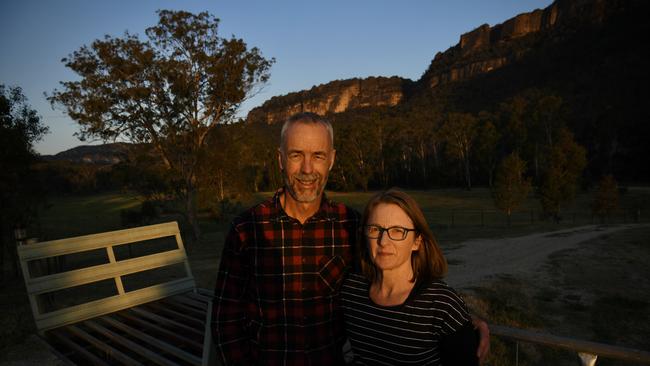
End of a dream
“The whole thing has just worn us down and for us not to want to be here any more,” says Darren Denmead, sitting on a couch in his living room with those enormous cliffs looming out through the window. “This has always been our dream place to live and all of a sudden it’s not.”
When the council closed the Wolgan Gap Rd last November the only access into the valley was via a precarious old fire trail called the Old Coach Rd, which was built early last century during the construction of a now disused railway line and tunnel. The rail line serviced the old shale oil refinery at Newnes in the Wolgan Valley and the tunnel is now the Glow Worm Tunnel.
A council four-wheel-drive would lead a convoy of four other vehicles in and out, once in the morning and once in the afternoon, up the Old Coach Rd. For those lucky enough to be in the convoy, it turned a 45-minute trip into Lithgow into a 1¾-hour slog.
Meanwhile, a new, temporary road – the Donkey Steps – was hastily built down a steep section, on the opposite side of the valley to where the Wolgan Gap Rd descends. It opened in March this year. The road, just a few degrees off being one of the steepest public roads in the world, is closed to all vehicles apart from four-wheel drives. It’s too steep for trucks. It’s locked and any visitors have to be let in and accompanied by a resident.
It became such a hassle for Denmead, who was the principal of a primary school in Bathurst, that he relinquished his role at the beginning of term two and went on long service leave. His wife, Sarah, has had a long association with the valley. Her great-grandfather was a Cobb and Co coach driver who braved the Wolgan Gap early last century. Her family has owned this farm, the Corn Paddock, since the 1940s.
They’ve not been able to run stock on their farm because the fences were destroyed by the fires. Darren Denmead has been slashing his fallow paddocks in an attempt to mitigate the fire risk as they now face another ominous fire season.
His big fear is that the Emirates resort will simply shut up shop, for good. “If they go we’ve got no voice at all,” he says. “The importance of (the resort’s) clout, politically, has probably kept us in the game.”
Denmead says the government response to their plight – local, state and federal – has been woeful, and they keep getting bounced between various agencies, with none taking responsibility.
Living through the bushfires was terrifying for all of them. “Thinking you were going to die was pretty ordinary, I can tell you,” he says.
Then came the rains. He says the culverts had not been cleaned out and the road had not been properly maintained. “I think that some of the damage could have been avoided, if the preventative maintenance had happened.” But it’s too late for all that now.
Denmead reckons if the resort was abandoned, it would probably be cheaper for the government to buy out all the landholders and turn it all back into national park rather than spending many tens of millions of dollars to put in a new road. “There are certainly rumours flying about that that could happen,” he says.
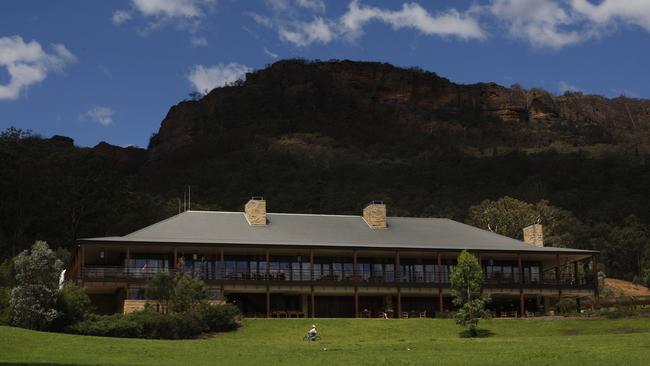
The resort was initially keen to talk to this publication and to put us in contact with employees and former employees who had been affected. Word then came from higher up that no employee of the resort was authorised to speak.
This puzzling response has only fuelled more rumours about the future of the luxury resort. Are they trying to sell, people ask. Are they about to pull out?
At its peak, the resort employed about 130 people. It’s now down to a skeleton maintenance staff. It was one of the biggest employers in Lithgow shire. The resort issued a statement to The Australian confirming it would be closed for at least “this year and next”, until at least the end of 2024.
“(The resort) was able to re-open on 1 April 2023 after a new road was constructed by Lithgow City Council,” a spokeswoman said. “However, the challenges of the road’s descent into the valley have made it impossible to continue supplying utilities and equipment to the degree required for the resort to operate smoothly. As a result of this closure, it is with regret that we have had to make the difficult decision to let go of a number of valued colleagues. This decision was not taken lightly.”
Around 90 staff, in total, have been made redundant. The Australian confirmed this week that the resort’s general manager, Tim Stanhope, has resigned and is leaving to take up a post in Vietnam.
This has had a dramatic impact on the businesses that service the resort. Ray Williams, who owns a butchery in nearby Portland, had been supplying meat to the hotel for many years.
“I just can’t understand why it’s been allowed to go on for so long without anyone doing anything about it,” Williams says. I tell him the best estimate at the moment is three to five years – from now – for road works to be completed. “Emirates will obviously walk away from it if it is going to take that long,” he says. He hopes he can avoid laying off staff.
The residents believe that if this was a big abattoir, manufacturing plant, a mine or a power station that was cut off, there would have been much more publicity and much more pressure on politicians and bureaucrats to come up with a speedier solution.
The uncertainty is eating away at everyone. Life is on permanent hold.
Paul and Jane Vought have a magnificent view of those sandstone cliffs from their property, Woolpack. Paul had been a tradesman in the mines and Jane worked at the NSW Police’s 24-hour call centre at Lithgow. They both retired early with a plan to run a wedding reception centre in a paddock looking out to where the sun sets behind those dramatic walls of stone. Paul built the handsome venue with his own hands, spending more than $100,000 on materials. They had all the necessary approvals. They’d built a website and had taken three bookings. And then the road was closed.
“We just can’t get people down here,” Paul says. “We tossed up buying a four-wheel drive bus to cart ’em down the Donkey Steps, but I just don’t think it’s feasible.” He’s also got 30 head of cattle, which he can’t get out, and now he’s running out of feed. “It’s heartbreaking, because we both gave up work to do this and it’s all fallen in a heap,” says Paul.
Jane adds: “We were so excited that in that first month people came down to have a look and booked it. It was exactly what they wanted.” They knew it was going to work. And then, disaster.
“It is just incredible to think that they have shut the whole valley,” she says. They say the communication about what will happen has been poor. “They just tell us what they think we want to hear,” says Paul.
Kristie Kearney, an ecologist, lives further up the valley. She had been running a successful tourism business, taking small groups on walking tours around the Wolgan. Her business was decimated by the fires and then, when the rains came and the road collapsed, it became impossible to continue. “It was heartbreaking,” she says. “I am incredibly passionate about what I do, being able to share this incredible part of the world with other people.”
She says that with climate change there are only going to be more extreme weather events and governments need to adapt. She cites the fact that the community could lose its $2m grant for a community centre/fire shelter because they don’t fit into the right box. “It’s ludicrous,” she says. “It was a recommendation from all those inquiries (into the bushfires) that communities be more prepared … we were doing that, and now we may lose our funding to build a fire shelter.”
A road too far
The general manager of Lithgow City Council, Craig Butler, says: “There’s no quick and easy solution.” Butler is proud of what the council has achieved with the construction of the Donkey Steps. “We got that approved and (constructed) in a record time,” he says. It’s a small council with only 230 staff servicing 22,000 residents over an enormous area.
“We can’t build the road back where it was originally built – it’s too dangerous – and so we have to build a whole new road through the most wondrous country and there is only one throat through which you can logically create a road,” he says.
Even though the council is responsible for the road, it simply doesn’t have the resources, the equipment or the expertise, which is why consultants from Sydney have been called in to design a new route. They are now looking at different designs and costs. “The guesstimate is above $30m but we don’t know how far above $30m.” Assurances have been given by the state and commonwealth governments that it will be funded.
As to how long it will take: “We are at a point where we can’t be specific, but it is certainly a multi-year project.”
The council told residents it had identified three possible routes. They were not told how long it would be before they could drive on it.
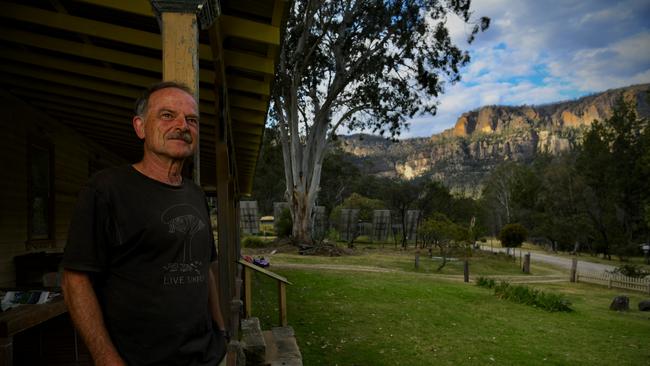
Butler says that with increasingly severe weather events there needs to be a different model to allow councils to cope with the catastrophic outcomes. “One wonders about the model, going forward,” he says. “I’m not sure that the various forms of government have enough fast twitch muscles for the effects of climate change.”
Federal Emergency Management Minister Murray Watt recently announced that Andrew Colvin, who led the recovery efforts after the Black Summer Bushfires, would conduct an independent review into more effective funding arrangements “in the face of increasingly frequent and more severe natural disasters”.
“We know communities are best placed to tell us what is and isn’t working from within the disaster management funding,” Watt says. “Those impacted by disasters … will be encouraged to have their say through an extensive consultation process.”
If they are looking for a case study, Colvin should brave the Donkey Steps and head down into the Wolgan. It is Watt’s department that has been threatening to withdraw the funding from the Wolgan Valley Association to build its new fire shelter.
Holding on to hope
Thomas Ebersoll has loved the Wolgan from the moment he stepped into the valley back in 1998, on a bushwalking and camping trip. On that trip there was a sign outside the old, dilapidated Newnes Hotel on a steel picket which read “For sale, inquire within”. He couldn’t resist.
The hotel, which was closed then and is now Ebersoll’s house, had been the drinking hole for the workers at the Newnes shale oil refinery – a massive industrial complex built in the early part of last century. The ruins are in the forest, a few kilometres down the river from the hotel.
In those 25 years he has built four simple but beautiful cabins, which he rents out, along with camping spaces along the river. The sign out the front says: “Everything money can’t buy.”
His business has been decimated by the road closure. People can still get in, by four wheel drive, but he has to let in every guest, and accompany them down the Donkey Steps. It’s a 50km trip, there and back, for every guest.
“I’ve lost about 80 per cent of my cabin business,” he says. “It’s picking up a bit because people appreciate the quiet and the seclusion.” He’s lost virtually all his camping business.
Ebersoll is in his late 60s and all the cleaning, the maintenance, the mowing and the chopping of wood was getting too much. He was exhausted and ready to sell. “I had made inquiries with the local real estate agent and he was about to set up a ‘worldwide’ campaign to market it,” he says.
And then the road closed.
In the early part of last century a tunnel was cut through the mountain, he says, and 52km of rail track laid, by hand, to service the shale oil refinery and mine, just down the river from the hotel. Back then, it took 16 months and it opened in 1907.
“I’m 68,” Ebersoll says. “It’s a good time to move on, but it’ll probably be five to 10 years before we have a new road. I hope I can hold out till then.”






To join the conversation, please log in. Don't have an account? Register
Join the conversation, you are commenting as Logout